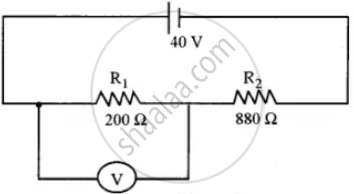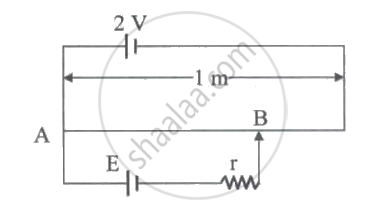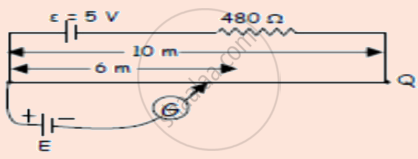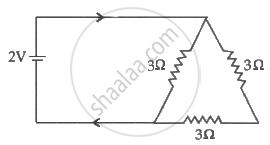Advertisements
Advertisements
प्रश्न
What will be the effect on the position of zero deflection if only the current flowing through the potentiometer wire is increased?
उत्तर
The potential gradient along the wire increases as the current through the potentiometer wire increases. As a result, the position of zero deflection will be at a shorter length.
APPEARS IN
संबंधित प्रश्न
State the principle of working of a potentiometer.
State the advantages of potentiometer over voltmeter.
State the principle of a potentiometer. Define potential gradient. Obtain an expression for potential gradient in terms of resistivity of the potentiometer wire.
State the working principle of a potentiometer. With the help of the circuit diagram, explain how a potentiometer is used to compare the emf's of two primary cells. Obtain the required expression used for comparing the emfs.
Write the principle of working of a potentiometer. Describe briefly, with the help of a circuit diagram, how a potentiometer is used to determine the internal resistance of a given cell.
Would you prefer a voltmeter or a potentiometer to measure the emf of a battery?
The potentiometer wire AB shown in the figure is 40 cm long. Where should the free end of the galvanometer be connected on AB, so that the galvanometer may show zero deflection?

Figure below shows two resistors R1 and R2 connected to a battery having an emf of 40V and negligible internal resistance. A voltmeter having a resistance of. 300 Ω is used to measure the potential difference across R1 Find the reading of the voltmeter.

Define or describe a Potentiometer.
State the uses of a potentiometer.
Describe how a potentiometer is used to compare the EMFs of two cells by connecting the cells individually.
Describe how a potentiometer is used to compare the emf's of two cells by the combination method.
Why is a potentiometer preferred over a voltmeter for measuring emf?
The resistance of a potentiometer wire is 8 Ω and its length is 8 m. A resistance box and a 2 V battery are connected in series with iL What should be the resistance in the box if it is desired to have a potential drop of 1 µV/mm?
The emf of a cell is balanced by a length of 120 cm of a potentiometer wire. When the cell is shunted by a resistance of 10 Ω, the balancing length is reduced by 20 cm. Find the internal resistance of the cell.
A cell of e.m.f 1.5V and negligible internal resistance is connected in series with a potential meter of length 10 m and the total resistance of 20 Ω. What resistance should be introduced in the resistance box such that the potential drop across the potentiometer is one microvolt per cm of the wire?
The emf of a standard cell is 1.5V and is balanced by a length of 300 cm of a potentiometer with a 10 m long wire. Find the percentage error in a voltmeter that balances at 350 cm when its reading is 1.8 V.
Which of the following instruments is not a direct reading instrument?
Two cells having unknown emfs E1 and E2 (E1 > E2) are connected in potentiometer circuit, so as to assist each other. The null point obtained is at 490 cm from the higher potential end. When cell E2 is connected, so as to oppose cell E1, the null point is obtained at 90 cm from the same end. The ratio of the emfs of two cells `("E"_1/"E"_2)` is ______.
The potentiometer is more sensitive, when ______.
The resistivity of potentiometer wire is 40 × 10-8 ohm - metre and its area of cross-section is 8 × 10-6 m2. If 0.2 ampere current is flowing through the wire, the potential gradient of the wire is ______.
A potentiometer wire has length L For given cell of emf E, the balancing length is `"L"/3` from 3 the positive end of the wire. If the length of the potentiometer wire is increased by 50%, then for the same cell, the balance point is obtained at length.
The length of a potentiometer wire is L. A cell of e.m.f E is balanced at length L/3 from the positive end of the wire. If the length of wire increases by L/2, then the same cell will give balance point at length ____________.
A potentiometer wire of Length 10 m is connected in series with a battery. The e.m.f. of a cell balances against 250 cm Length of wire. If length of potentiometer wire is increased by 1 m, the new balancing length of wire will be ____________.
If the e.m.f of a cell is not constant in the metre bridge experiment, then the ____________.
Which of the following is true for a potentiometer?
To determine the internal resistance of a cell by using potentiometer, the null point is at 1 m when cell is shunted by 3 Ω resistance and at a length 1.5 m when cell is shunted by 6 Ω resistance. The internal resistance of the cell is ______.
A cell of e.m.f. 'E' is connected across a resistance 'R'. The potential difference across the terminals of the cell is 90% ofE. The internal resistance of the cell is ______.
A potentiometer wire of length 100 cm has a resistance of 10 `Omega.` It is connected in series with a resistance and an accumulator of e.m.f 2 V and of negligible internal resistance. A source of e.m.f 10 mV is balanced against a 40 cm length of the potentiometer wire. The value of the external resistance is ____________.
A potentiometer wire is 10 m long and has resistance of 2`Omega`/m. It is connected in series with a battery of e.m.f 3 V and a resistance of 10 `Omega`. The potential gradient along the wire in V/m is ______.
When two cells of e.m.f 1.5 V and 1.1 V connected in series are balanced on a potentiometer, the balancing length is 260 cm. The balancing length, when they are connected in opposition is (in cm) ____________.
In the given figure, battery E is balanced on 55 cm length of potentiometer wire but when a resistance of 10 `Omega` is connected in parallel with the battery, then it balances on 50 cm length of the potentiometer wire. The internal resistance r of the battery is ____________.

A potentiometer is used to measure the potential difference between A and B, the null point is obtained at 0.9 m. Now the potential difference between A and C is measured, the null point is obtained at 0.3 m. The ratio `E_2/E_1` is (E1 > E2) ______

The current drawn from the battery in the given network is ______
(Internal resistance of the battery is neglected)

A potentiometer wire is 4 m long and a potential difference of 3 V is maintained between the ends. The e.m.f. of the cell which balances against a length of 100 cm of the potentiometer wire is ______
The sensitivity of the potentiometer can be increased by ______.
A battery is connected with a potentiometer wire. The internal resistance of the battery is negligible. If the length of the potentiometer wire of the same material and radius is doubled then ______.
A 10 m long wire of uniform cross-section and 20 Ω resistance is used in a potentiometer. The wire is connected in series with a battery of 5 V along with an external resistance of 480 Ω. If an unknown emf E is balanced at 6.0 m length of the wire, then the value of unknown emf is ______.

The value of current I in the network shown in fig.

Specific resistance of a conductor increase with.
1°C rise in temperature is observed in a conductor by passing a certain current. If the current is double then the rise in temperature is approximately.
In a potentiometer circuit, a cell of EMF 1.5 V gives balance point at 36 cm length of wire. If another cell of EMF 2.5 V replaces the first cell, then at what length of the wire, the balance point occurs?
In a potentiometer circuit a cell of EMF 1.5 V gives balance point at 36 cm length of wire. If another cell of EMF 2.5 V replaces the first cell, then at what length of the wire, the balance point occurs?
Potential difference between the points A and B in the circuit shown is 16 V, then potential difference across 2Ω resistor is ______ V. volt. (VA > VB)

If you are provided a set of resistances 2Ω, 4Ω, 6Ω and 8Ω. Connect these resistances so as to obtain an equivalent resistance of `46/3`Ω.
A cell of internal resistance r is connected across an external resistance nr. Then the ratio of the terminal voltage to the emf of the cell is ______.
In balanced meter bridge, the resistance of bridge wire is 0.1 Ω cm. Unknown resistance X is connected in left gap and 6 Ω in right gap, null point divides the wire in the ratio 2:3. Find the current drawn from the battery of 5 V having negligible resistance.
What will a voltmeter of resistance 200 Ω read when connected across a cell of emf 2 V and internal resistance 2 Ω?
What should be the diameter of a soap bubble such that the excess pressure inside it is 51.2 Pa? [Surface tension of soap solution = 3.2 × 10−2 N/m]
Draw neat labelled diagram of potentiometer as voltage divider.
In a potentiometer, a cell is balanced against 110 cm when the circuit is open. A cell is balanced at 100 cm when short-circuited through a resistance of 10 Ω. Find the internal resistance of the cell.
